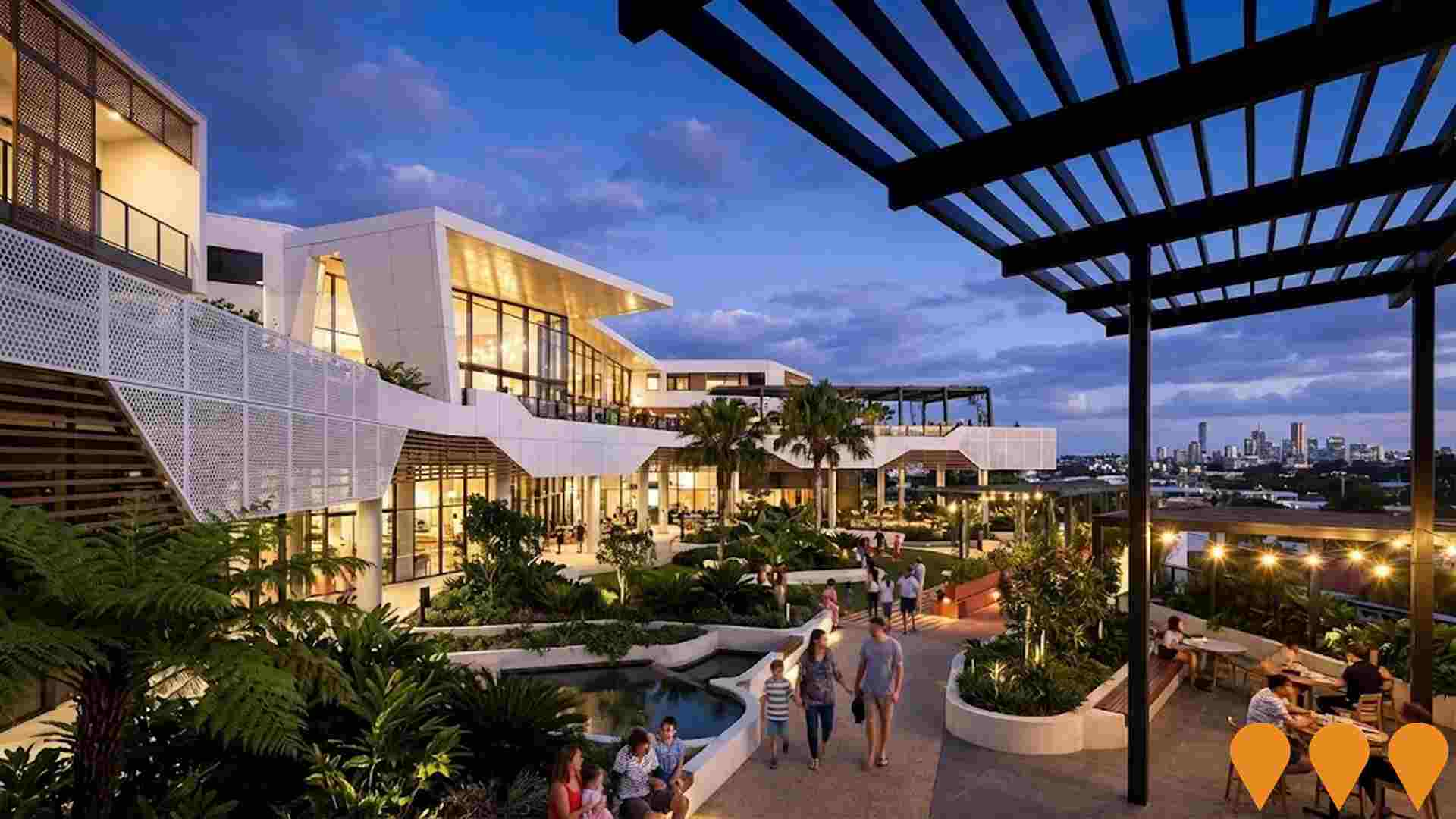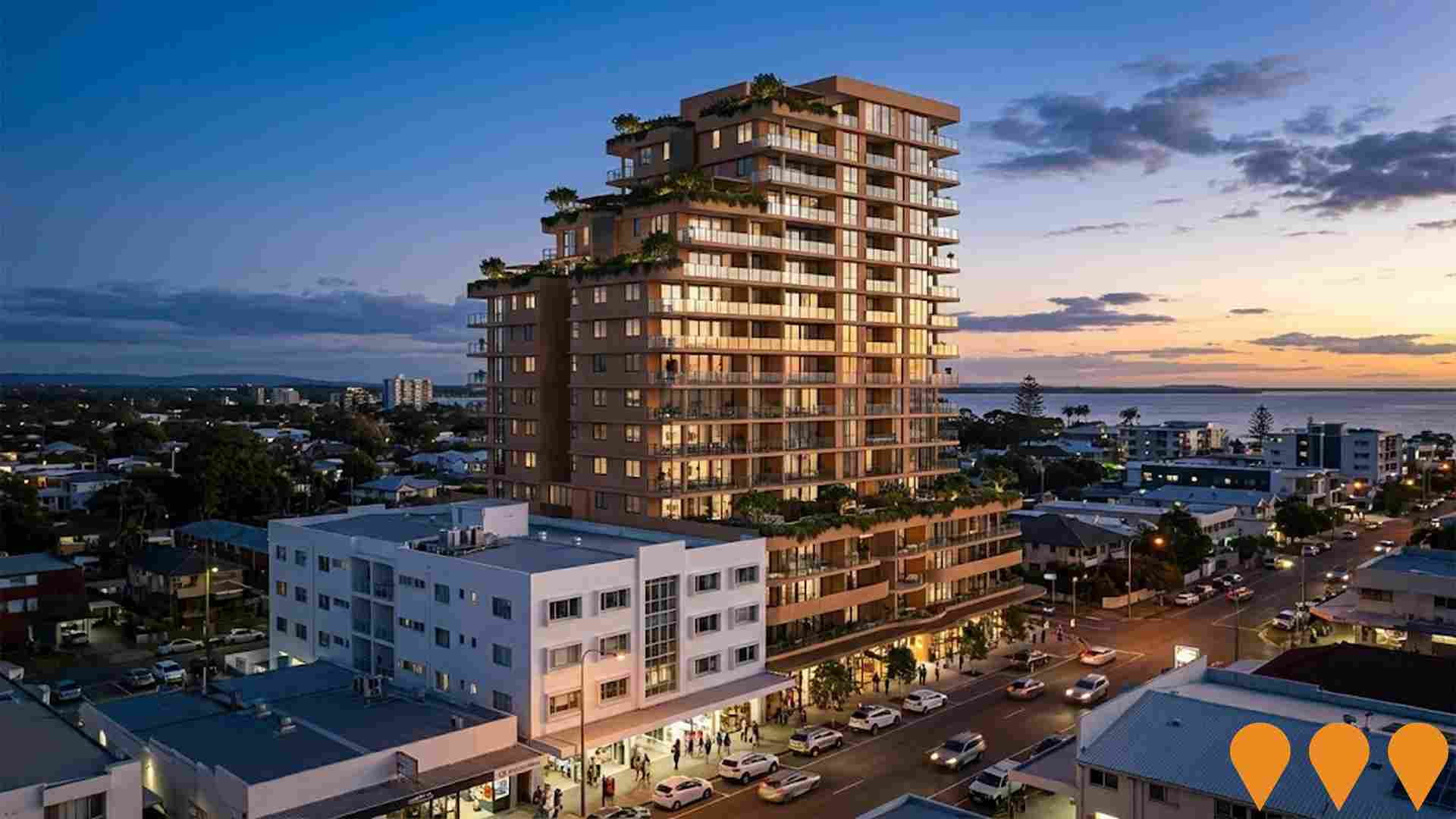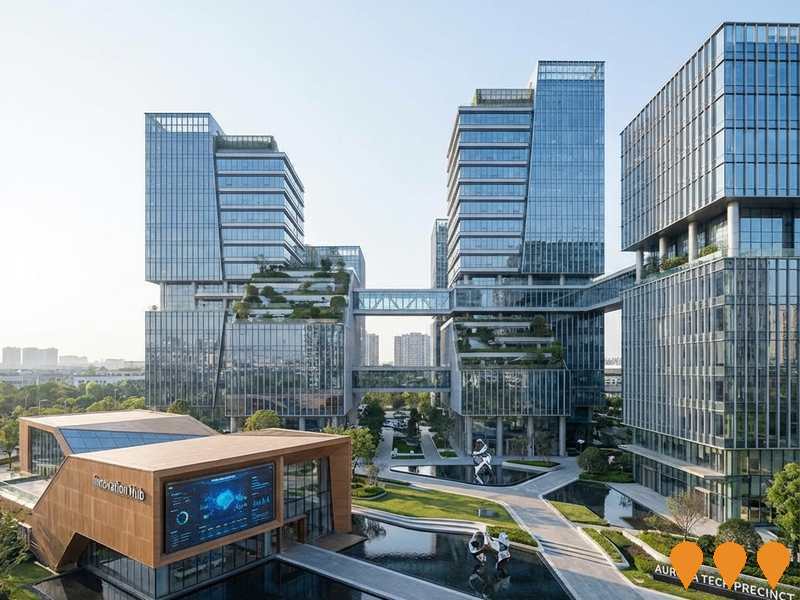Chart Color Schemes
est. as @ -- *
ABS ERP | -- people | --
2021 Census | -- people
Sales Activity
Curious about local property values? Filter the chart to assess the volume and appreciation (including resales) trends and regional comparisons, or scroll to the map below view this information at an individual property level.
Find a Recent Sale
Sales Detail
Population
Wynnum lies within the top quartile of areas nationally for population growth performance according to AreaSearch analysis of recent, and medium to long-term trends
Wynnum's population was around 15,479 as of August 2025. This showed an increase of 977 people from the 2021 Census figure of 14,502, reflecting a growth rate of 6.7%. The change was inferred from the ABS's estimated resident population of 15,268 in June 2024 and an additional 170 validated new addresses since the Census date. Wynnum's population density was 2,525 persons per square kilometer as of August 2025, placing it in the upper quartile nationally according to AreaSearch assessments. Wynnum's growth rate exceeded that of its SA3 area (6.4%) between the 2021 Census and June 2024. Overseas migration contributed approximately 81.7% of overall population gains during this period.
For projections, AreaSearch uses ABS/Geoscience Australia data released in 2024 with a base year of 2022 for each SA2 area. For areas not covered by this data and years post-2032, Queensland State Government's SA2 area projections from 2023 are adopted, using proportional growth weightings based on ABS Greater Capital Region projections released in 2023 with a base year of 2022 for each age cohort. Future projections indicate above median population growth nationally, with Wynnum expected to increase by 3,331 persons to 2041, reflecting a total gain of 20.2% over the 17-year period.
Frequently Asked Questions - Population
Development
AreaSearch assessment of residential approval activity sees Wynnum among the top 30% of areas assessed nationwide
Wynnum has averaged approximately 86 new dwelling approvals annually. Over the past five financial years, from FY21 to FY25, a total of 432 homes were approved, with an additional 9 approved so far in FY26. Each year, around 2.1 people have moved to the area per new home constructed over these five years, reflecting strong demand that supports property values.
New homes are being built at an average expected construction cost value of $671,000, indicating a focus on the premium segment with upmarket properties. This financial year has seen $5.3 million in commercial approvals registered, suggesting limited commercial development focus compared to residential development. Compared to Greater Brisbane, Wynnum has slightly more development activity, with 33.0% above the regional average per person over the past five years, maintaining good buyer choice while supporting existing property values. However, recent periods have shown a moderation in development activity. New building approvals show 41.0% detached houses and 59.0% townhouses or apartments, reflecting a shift towards compact living that offers affordable entry pathways for downsizers, investors, and first-time purchasers.
This represents a notable change from the area's existing housing composition, which is currently 71.0% houses, indicating decreasing availability of developable sites and changing lifestyles. Wynnum reflects a transitioning market with around 226 people per approval. Looking ahead, Wynnum is projected to grow by approximately 3,120 residents through to 2041. Construction activity is maintaining pace with this projected growth, although buyers may face growing competition as the population increases.
Frequently Asked Questions - Development
Infrastructure
Wynnum has strong levels of nearby infrastructure activity, ranking in the top 40% nationally
Changes to local infrastructure significantly influence an area's performance. AreaSearch has identified 33 projects likely impacting the area. Key projects include Royal Far West Neighbourhood Development, Wynnum Centre Suburban Renewal Precinct, Wynnum Plaza Redevelopment, and BMD Group Headquarters. The following list details those most relevant.
Professional plan users can use the search below to filter and access additional projects.
INFRASTRUCTURE SEARCH
 Denotes AI-based impression for illustrative purposes only, not to be taken as definitive under any circumstances. Please follow links and conduct other investigations from the project's source for actual imagery. Developers and project owners wishing us to use original imagery please Contact Us and we will do so.
Denotes AI-based impression for illustrative purposes only, not to be taken as definitive under any circumstances. Please follow links and conduct other investigations from the project's source for actual imagery. Developers and project owners wishing us to use original imagery please Contact Us and we will do so.
Frequently Asked Questions - Infrastructure
Wynnum Plaza Redevelopment
Shayher Group's approved masterplan for Wynnum Plaza includes a large-scale, multi-staged retail and residential redevelopment. The proposal, designed by ZENX Architects, features new lifestyle retail precincts, a boutique cinema, commercial office space, and eight residential buildings comprising 184 apartments situated above the podium. It also includes new food and beverage outlets and extensive communal open space across the 94,930sqm site. The development aims to create an enhanced hub for economic and social exchange and is planned for six stages of construction to keep the centre operational.

Royal Far West (RFW) Neighbourhood Development
58 luxury apartments across two buildings on a 15,000sqm beachfront site in Manly. Development includes revitalised accommodation for visiting families and community amenities. Designed by Glenn Murcutt AO and Angelo Candalepas.

Wynnum Centre Suburban Renewal Precinct
Brisbane City Council suburban renewal precinct plan for Wynnum centre to revitalise the bayside precinct with new housing and employment opportunities, while maximising connections to public transport and the foreshore. Aims to create a vibrant suburban hub with improved public spaces, transport connections, and mixed-use development opportunities.

Ora - 27-Storey Mixed-Use Development (Withdrawn)
HamBros' proposed $130 million 27-storey mixed-use development at 74 Charlotte Street and 89 Bay Terrace featuring 275 apartments (one, two and three bedroom), retail space, two levels of commercial space, and recreational facilities with bay views including a fifth-floor recreation level with restaurant, bar, pool terrace, spa, sauna, steam rooms, cinema, BBQs, meeting rooms, wine rooms, gym, and function rooms. Project withdrawn due to escalating construction costs (potentially exceeding $400 million), uncertainty from upcoming Council election, and Council requests for changes in building design, stormwater management, traffic impacts, refuse storage, landscape, and noise impacts.

BMD Group Headquarters
New 6-storey headquarters for BMD Group at 168 Bay Terrace, Wynnum, housing approximately 450 employees. Features mixed-use ground floor with retail spaces, cafes, and community facilities. Designed by i2C Architects with architectural elements paying homage to the historic Wynnum Baptist Church previously on site. The church was relocated to Iona College in 2023.

One West Avenue
A mixed-use precinct delivering approximately 400 apartments, 12 villas, and commercial spaces including medical hubs, cafes, and community facilities adjacent to Wynnum Central Train Station to support population growth and urban renewal.

Lindum Rail Crossing Upgrade
Upgrade of the Lindum rail crossing in Wynnum West to improve safety for all road users through realigning the intersection, installing traffic signals, controlled pedestrian crossings, and new shared paths. Joint funding by Australian Government, Queensland Government and Brisbane City Council. Part of Brisbane's broader transport infrastructure improvements in the bayside area.

Manly Hotel Refurbishment
Refurbishment and modernisation of the historic Manly Hotel. Upgrades include improved dining facilities, accommodation, and entertainment areas while preserving heritage character.

Employment
Employment conditions in Wynnum demonstrate strong performance, ranking among the top 35% of areas assessed nationally
Wynnum has a highly educated workforce with strong representation in essential services sectors. Its unemployment rate was 3.2% as of the past year, which saw an estimated employment growth of 5.0%.
As of June 2025, Wynnum's unemployment rate is 0.9% lower than Greater Brisbane's rate of 4.1%, with workforce participation rates broadly similar at 64.5%. Residents' employment is concentrated in health care & social assistance, construction, and education & training sectors. Notably, transport, postal & warehousing has a high concentration with levels at 1.2 times the regional average. However, health care & social assistance has limited presence with 14.4% employment compared to the regional average of 16.1%.
The predominantly residential area offers limited local employment opportunities, as indicated by the Census working population count versus resident population. Over a 12-month period ending in May 2025, employment in Wynnum increased by 5.0%, while the labour force grew by 4.4%, leading to a fall in unemployment rate of 0.6 percentage points. In comparison, Greater Brisbane saw employment rise by 4.4% and unemployment fall by 0.4 percentage points. National employment forecasts from Jobs and Skills Australia project growth of 6.6% over five years and 13.7% over ten years. Applying these projections to Wynnum's employment mix suggests local growth of approximately 6.6%% over five years and 13.6% over ten years, though these are simple weighting extrapolations for illustrative purposes only and do not account for localized population projections.
Frequently Asked Questions - Employment
Income
The area exhibits notably strong income performance, ranking higher than 70% of areas assessed nationally through AreaSearch analysis
Wynnum's median income among taxpayers was $59,067 in financial year 2022. The average income stood at $72,482 during the same period. In comparison, Greater Brisbane's median and average incomes were $55,645 and $70,520 respectively. Based on a Wage Price Index growth of 13.99% since financial year 2022, current estimates for Wynnum would be approximately $67,330 (median) and $82,622 (average) as of September 2025. Census data shows that household, family and personal incomes in Wynnum cluster around the 63rd percentile nationally. The largest income bracket comprises 29.3% earning between $1,500 to $2,999 weekly, with a total of 4,535 residents falling into this category. This is consistent with broader trends across the broader area, where 33.3% fall within the same income bracket. High housing costs consume 17.1% of income in Wynnum. Despite this, strong earnings place disposable income at the 57th percentile nationally. The area's SEIFA income ranking places it in the 6th decile.
Frequently Asked Questions - Income
Housing
Wynnum is characterized by a predominantly suburban housing profile, with above-average rates of outright home ownership
Dwelling structure in Wynnum, as per the latest Census, consisted of 71.4% houses and 28.7% other dwellings (semi-detached, apartments, 'other' dwellings). This compared to Brisbane metro's 71.4% houses and 28.6% other dwellings. Home ownership in Wynnum was at 28.7%, similar to Brisbane metro, with mortgaged dwellings at 36.2% and rented ones at 35.1%. The median monthly mortgage repayment in Wynnum was $2,167, higher than Brisbane metro's average of $2,100. Median weekly rent in Wynnum was $400, slightly above Brisbane metro's figure of $420. Nationally, Wynnum's mortgage repayments were significantly higher than the Australian average of $1,863, while rents were exceeding the national figure of $375.
Frequently Asked Questions - Housing
Household Composition
Wynnum has a typical household mix, with a lower-than-average median household size
Family households account for 69.0% of all households, including 30.2% couples with children, 26.0% couples without children, and 11.4% single parent families. Non-family households make up the remaining 31.0%, with lone person households at 27.7% and group households comprising 3.3% of the total. The median household size is 2.4 people, which is smaller than the Greater Brisbane average of 2.6.
Frequently Asked Questions - Households
Local Schools & Education
The educational profile of Wynnum exceeds national averages, with above-average qualification levels and academic performance metrics
The area's university qualification rate is 31.0% among residents aged 15+, surpassing the SA4 region average of 23.7% and Queensland's state average of 25.7%. Bachelor degrees are the most common at 20.5%, followed by postgraduate qualifications (6.7%) and graduate diplomas (3.8%). Vocational credentials are also prevalent, with 34.8% of residents aged 15+ holding such qualifications - advanced diplomas account for 11.6% and certificates for 23.2%.
Educational participation is high at 28.2%, with 9.3% in primary education, 8.3% in secondary education, and 5.2% pursuing tertiary education. Wynnum's four schools have a combined enrollment of 2,259 students, serving distinct age groups with balanced educational opportunities (ICSEA: 1046). The area has three primary and one secondary school. Note: for schools showing 'n/a' in enrollments, please refer to the parent campus.
Frequently Asked Questions - Education
Schools Detail
Nearby Services & Amenities
Transport
Transport servicing is good compared to other areas nationally based on assessment of service frequency, route connectivity and accessibility
Wynnum has 77 active public transport stops, offering a mix of train and bus services. These stops are served by 26 different routes, collectively facilitating 2,188 weekly passenger trips. The average distance from residents to the nearest transport stop is 193 meters, indicating excellent accessibility.
On average, there are 312 trips per day across all routes, which equates to approximately 28 weekly trips per individual stop.
Frequently Asked Questions - Transport
Transport Stops Detail
Health
Health performance in Wynnum is lower than average with common health conditions somewhat prevalent across both younger and older age cohorts
Wynnum faces significant health challenges, with common health conditions prevalent across both younger and older age cohorts. The rate of private health cover is high at approximately 55% of the total population (~8,559 people), compared to 58.6% across Greater Brisbane.
Mental health issues impact 9.0% of residents, while arthritis affects 8.4%. 67.8% of residents declare themselves completely clear of medical ailments, compared to 69.4% across Greater Brisbane. As of 2018-2023, 20.2% of residents are aged 65 and over (3,125 people), which is higher than the 16.7% in Greater Brisbane. Health outcomes among seniors present some challenges, broadly in line with the general population's health profile.
Frequently Asked Questions - Health
Cultural Diversity
In terms of cultural diversity, Wynnum records figures broadly comparable to the national average, as found in AreaSearch's assessment of a number of language and cultural background related metrics
Wynnum's population, born in Australia, was 77.2%, with 87.0% being citizens and 92.1% speaking English only at home. Christianity was the predominant religion, at 50.8%. Comparatively, Greater Brisbane had 52.5% Christians.
Top ancestry groups were English (30.6%), Australian (23.9%), and Irish (10.4%). Notably, Maori (1.5%) and New Zealand (1.2%) groups were slightly overrepresented in Wynnum compared to regional averages of 1.4% and 1.3%, respectively. Scottish ancestry was also notably higher at 9.1%.
Frequently Asked Questions - Diversity
Age
Wynnum hosts an older demographic, ranking in the top quartile nationwide
The median age in Wynnum is 43 years, significantly higher than Greater Brisbane's average of 36 years and Australia's median age of 38 years. The 55-64 age group comprises 13.9% of the population in Wynnum, compared to a lower prevalence of the 25-34 cohort at 9.5%. Post-2021 Census data shows that the 75 to 84 age group has grown from 5.0% to 6.5%, while the 65 to 74 cohort increased from 10.2% to 11.2%. Conversely, the 45 to 54 age group has declined from 15.9% to 14.7%. Population forecasts for 2041 indicate substantial demographic changes in Wynnum. The 75 to 84 age group is projected to grow by 91%, reaching 1,903 people from 998. Notably, the combined 65+ age groups are expected to account for 63% of total population growth, reflecting Wynnum's aging demographic profile. In contrast, the 0 to 4 and 35 to 44 cohorts are forecasted to experience population declines.
